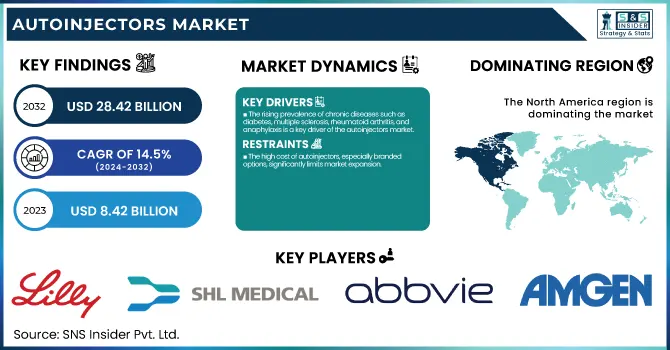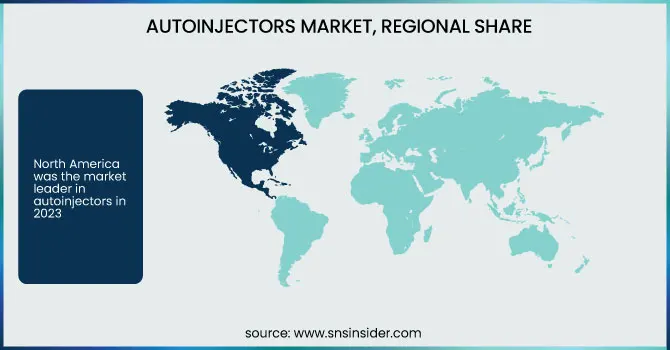Global Autoinjectors Market Size:
The Autoinjectors Market size was valued at USD 8.42 billion in 2023 and is projected to reach USD 28.42 billion by 2032, with a CAGR of 14.5% from 2024 to 2032.

To Get More Information on Autoinjectors Market - Request Sample Report
This report provides regional pricing analysis and trends driven by manufacturing costs, reimbursement policy, and competitive market dynamics. It examines technological innovation and patent trends, with technologies in drug delivery systems and user-friendly devices improving patient compliance. It also looks at consumer attitudes and market demand, highlighting trends toward self-administration, compact size, and needle-free devices. Prescribing and use patterns for autoinjectors differ geographically, driven by regulatory approvals, physician prescribing, and endemic disease. The study also evaluates regulatory and compliance factors driving growth, with changing standards of safety and government regulations affecting product development and commercialization. Healthcare expenditures on autoinjectors are evaluated across government, commercial, private, and out-of-pocket categories, with varying levels of access and affordability.
The U.S. Autoinjectors Market size was valued at USD 2.81 billion in 2023 and is projected to reach USD 8.62 billion by 2032, with a CAGR of 13.28% from 2024 to 2032. In the United States, the market for autoinjectors is growing with increasing demand for the management of chronic diseases, rising uptake of biologics, and policy initiatives aimed at enhancing affordability through competition from biosimilars.
Autoinjectors Market Dynamics
Drivers
-
The rising prevalence of chronic diseases such as diabetes, multiple sclerosis, rheumatoid arthritis, and anaphylaxis is a key driver of the autoinjectors market.
As per the International Diabetes Federation, 537 million adults worldwide lived with diabetes in 2023, driving the demand for insulin autoinjectors. Further, the rising prevalence of multiple sclerosis, which affects more than 2.8 million patients worldwide, has contributed to the explosive demand for disease-modifying therapies (DMTs) in autoinjector presentation. The prevalence of severe allergic reactions has also prompted growth in epinephrine autoinjectors, especially in pediatric and at-risk populations. Technological innovations have improved the market, with intelligent autoinjectors featuring Bluetooth and NFC to facilitate real-time dose monitoring and adherence tracking. The trend toward home healthcare has boosted the use of disposable autoinjectors, enabling patients to administer drugs independently without clinical oversight. Moreover, the launch of biosimilar-based autoinjectors has made biologic therapies more accessible while lowering treatment expenses. Pharmaceutical firms are emphasizing ergonomic, single-step activation formats to enhance ease of use and patient compliance. Positive regulatory guidelines and increasing awareness campaigns for self-administered therapies further drive market growth. With the trend towards personalized medicine, autoinjectors are likely to remain the drug delivery device of choice over conventional syringes and vials.
Restraints
-
The high cost of autoinjectors, especially branded options, significantly limits market expansion.
The cost of an EpiPen has increased more than 500% during the last decade, leaving many patients without an affordable way to purchase these lifesaving devices. Incomplete reimbursement policies from several healthcare systems hinder access even more. Biosimilars that can provide alternative products at reduced cost are gradually gaining acceptance in slow motion due to the delay from physicians, complexity of guidelines to follow, and initial financial burden to bear to develop and get FDA/EMA approvals, thereby decreasing competitiveness for the bigger companies.
Device-related complications are another hindrance. Research indicates that more than 10% of users of autoinjectors report incorrect use, which results in unsuccessful treatment. Complications like needle phobia, misfiring by accident, and dose miscalculation deter patient compliance. Environmental issues regarding plastic waste from disposable autoinjectors also become an increasingly daunting challenge. As global trends move toward sustainability, the absence of efficient recycling processes for autoinjector parts complicates waste disposal.
Opportunities
-
The increasing demand for biosimilar-based autoinjectors presents a significant opportunity for market expansion.
Authorization of biosimilars for etanercept (Enbrel) and adalimumab (Humira) decreased the cost of treatment, hence making self-injectable biologics widely available. More patients can achieve cost-effective benefits as biosimilar uptake increases, thus increasing autoinjector demand. Technological innovation is creating new doors, especially in the form of intelligent autoinjectors that contain dose-tracking sensors, automatic reminders, and smartphone app connectivity. BD and Ypsomed are at the forefront of AI-based autoinjectors that track medicine adherence and deliver real-time alerts to patients and caregivers. Increased demand for targeted medicine also leads to demand for personalized autoinjectors designed with unique dosing and patient needs in mind, like weight-adapted insulin pens for child diabetes patients.
The telemedicine and home healthcare boom has further spurred market growth. With increasing numbers of patients opting for self-administration, pharmaceutical firms are emphasizing ergonomic, one-hand-activating devices to address elderly and disabled patients. Emerging markets in the Middle East, Latin America, and Asia are also seeing increased adoption as a result of better healthcare infrastructure and government support for self-administered therapies. With the development of the industry, future market sustainability is anticipated to be driven by innovations in reusable designs and biodegradable autoinjectors that provide cost-effective and eco-friendly solutions.
Challenges
-
One of the biggest challenges in the autoinjectors market is the rising number of product recalls and device failures.
Autoinjectors must be engineered carefully for effective delivery of drugs, but misfire, leakage, and partial injections are frequent complaints. In 2020, one of the biggest pharmaceutical companies had to recall 500,000 epinephrine autoinjectors for safety reasons, compromising consumer confidence and triggering increased regulatory oversight. Recalls thus breed uncertainty in patients and medical practitioners alike, reducing market adoption. Another major challenge is patient non-adherence and needle phobia. Research has shown that 20% of patients who are prescribed autoinjectors refuse or misuse them because of needle fear, decreasing the effectiveness of treatment. Although manufacturers have made ergonomic designs available, psychological barriers continue to be a challenge. Supply chain interruptions and raw material shortages have also affected the production of autoinjectors.
Autoinjectors Market Segmentation Analysis
By Type
The disposable autoinjectors market led in 2023, with a market share of 55.8%. The ease of use, convenience, and lower chances of contamination make them a leading choice in the case of self-administration. Additionally, the increased demand for single-use, prefilled autoinjectors for chronic disease management further strengthened this segment as a leader.
The reusable autoinjectors segment was the fastest-growing category, led by growing consumer awareness of cost savings and sustainability. The devices are cost-effective in the long term, as they provide cartridge replacement rather than full disposal, and thus are a preferred option for frequent users.
By Indication
The diabetes segment contributed the largest share of 26.4% in 2023 due to the growing number of cases of diabetes across the globe and increased use of insulin autoinjectors for self-administration. Increasing demand for portable, easy-to-use devices by diabetic patients, coupled with favorable reimbursement policies, has fueled the strong position of this segment.
The multiple sclerosis segment showed the highest growth, as more and more patients need regular self-injection treatments. The increased approval of disease-modifying therapies (DMTs) in autoinjector presentations and increasing awareness regarding early initiation of treatment have led to its strong growth.
By End Use
The homecare settings segment contributed the highest revenue share of 53.9% in 2023 due to the growing trend toward self-injection of drugs. Drivers like the convenience of treatment at home, the growth of telehealth services, and technological improvements in easy-to-use autoinjectors have made this segment dominant.
The most rapidly expanding segment was hospitals & clinics, with healthcare professionals increasingly using autoinjectors for outpatient procedures and emergencies. The increasing prevalence of anaphylaxis, in which immediate epinephrine administration is essential, has resulted in the increased use of autoinjectors in the clinical environment. Patient education and initial device use are also facilitated by hospitals and clinics, further contributing to demand.
Autoinjectors Market Regional Insights
North America was the market leader in autoinjectors in 2023, owing to the high adoption of biologic drugs, developed healthcare infrastructure, and favorable reimbursement policies. The country leading the region is the U.S., where a large number of patients depend on epinephrine autoinjectors for anaphylaxis and self-injectable biologics for chronic diseases such as multiple sclerosis and rheumatoid arthritis. Also, the FDA approval of biosimilar autoinjectors like Amjevita (biosimilar to Humira) has opened up greater access to affordable treatments for patients. The availability of major players like Mylan, Eli Lilly, and AbbVie also spurs innovation and market growth.
The Asia-Pacific is the fastest growing market, driven by an escalating diabetic population, a growing number of autoimmune diseases, and increased healthcare investments in China, India, and Japan. Governmental support for biosimilar-based treatments and homecare patient treatment has fueled demand growth. Moreover, the growth in pharmaceutical manufacturing across Asia is decreasing the cost and increasing the accessibility of autoinjectors, contributing to fast growth in the market.

Get Customized Report as per Your Business Requirement - Enquiry Now
Key Players in the Autoinjectors Market
-
Eli Lilly – Humalog KwikPen, Trulicity Pen
-
SHL Medical AG – Molly, DAI (Disposable Autoinjector)
-
AbbVie, Inc. – Humira Pen
-
Amgen – Enbrel SureClick, Repatha SureClick
-
Owen Mumford – Autoject, UniSafe
-
Ypsomed – YpsoMate, YpsoPen
-
Teva Pharmaceutical – Teva’s Epinephrine Auto-Injector
-
Biogen Idec – Avonex Pen, Plegridy Pen
-
Mylan N.V. – EpiPen, Semglee Autoinjector
-
Pfizer, Inc. – Genotropin Pen, Nivestym Autoinjector
-
Sanofi – Auvi-Q, SoloStar Pens (Lantus SoloStar, Apidra SoloStar)
-
Gerresheimer – SensAir, Gx Inbeneo
Recent Developments
In Jan 2025, Kindeva Drug Delivery’s Meridian Medical Technologies secured a contract worth up to USD 129 million to supply DuoDote autoinjectors, a chemical nerve agent antidote, to the U.S. Strategic National Stockpile (SNS) under the ASPR, U.S. Department of Health and Human Services.
In Nov 2024, Amneal Pharmaceuticals resubmitted its NDA to the U.S. FDA for a dihydroergotamine (DHE) prefilled syringe autoinjector for treating migraines and cluster headaches. Additionally, the company received FDA approval for exenatide, its first generic injectable GLP-1 agonist, highlighting its advancements in peptide development and drug-device combinations.
| Report Attributes | Details |
| Market Size in 2023 | USD 8.42 billion |
| Market Size by 2032 | USD 28.42 billion |
| CAGR | CAGR of 14.5% From 2024 to 2032 |
| Base Year | 2023 |
| Forecast Period | 2024-2032 |
| Historical Data | 2020-2022 |
| Report Scope & Coverage | Market Size, Segments Analysis, Competitive Landscape, Regional Analysis, DROC & SWOT Analysis, Forecast Outlook |
| Key Segments | • By Type [Disposable auto-injectors, Reusable auto-injectors (Prefilled, Empty)] • By Indication [Rheumatoid Arthritis, Multiple Sclerosis, Diabetes, Anaphylaxis, Other Therapies] • By End Use [Homecare Settings, Hospitals & Clinics, Ambulatory Surgical Centers] |
| Regional Analysis/Coverage | North America (US, Canada, Mexico), Europe (Eastern Europe [Poland, Romania, Hungary, Turkey, Rest of Eastern Europe] Western Europe] Germany, France, UK, Italy, Spain, Netherlands, Switzerland, Austria, Rest of Western Europe]), Asia Pacific (China, India, Japan, South Korea, Vietnam, Singapore, Australia, Rest of Asia Pacific), Middle East & Africa (Middle East [UAE, Egypt, Saudi Arabia, Qatar, Rest of Middle East], Africa [Nigeria, South Africa, Rest of Africa], Latin America (Brazil, Argentina, Colombia, Rest of Latin America) |
| Company Profiles | Eli Lilly, SHL Medical AG, AbbVie, Inc., Amgen, Owen Mumford, Ypsomed, Teva Pharmaceutical, Biogen Idec, Mylan N.V., Pfizer, Inc., Sanofi, Gerresheimer. |

